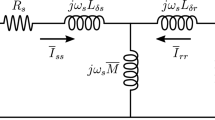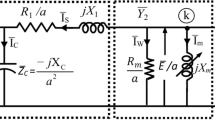Abstract
This paper concentrates on the estimation of the magnitude and frequency of the spectral components of line current that may be used for sensorless speed detection. The prediction method uses a mixture of permeance-magnetomotive force, finite element and reluctance mesh techniques to establish the airgap magnetic field. This traditional type of approach is chosen to maintain a visible link between cause and effect, so enhancing understanding of complex interactions. The approach is enhanced by the use of slot permeance effects calculated by finite element techniques, where saturation due to the current carrying conductors in the slots is incorporated. Further enhancements include examining slot permeance effects over one or more poles so that the influence of the spatial distribution of slot currents and slot top saturation can be incorporated. The large number of independent speed harmonic terms found experimentally in the line current spectrum is explained by rotor pole aliasing. Special equivalent circuits are introduced to enable these current harmonics to be predicted. A thorough experimental validation of the model is then conducted using a 30-kW experimental machine with adjustable eccentricity, rotors of different slotting form, slot number and skew to determine their effect on the speed-dependent harmonic components. Very good agreement was observed.











Similar content being viewed by others
Abbreviations
- B :
-
flux density
- D :
-
diameter of stator bore
- F :
-
magnetomotive force
- I :
-
rms current
- L :
-
length of machine
- N ph :
-
number of series turn per phase
- R :
-
number of rotor slot
- S :
-
number of stator slot
- Z :
-
impedance
- e :
-
induced EMF
- f :
-
frequency
- k w , k p :
-
winding and pitch factors
- l g :
-
airgap length
- s :
-
slip
- t :
-
time
- v :
-
rms value of induced EMF
- ε :
-
relative eccentricity
- φ :
-
flux
- Λ :
-
permeance
- θ :
-
αngular distance
- ω :
-
angular frequency
- i, j, n, m :
-
integers
- r:
-
for rotor
- s:
-
for stator
- h:
-
harmonic
- sa:
-
saturation
- se:
-
static eccentricity
- so:
-
source
References
Penman J, Dey MN (1986) Condition monitoring of electrical drives. IEE Proc B 133:142–148
Schoen RR, Habetler TG (1995) Effects of time varying loads on rotor fault detection in induction machines. IEEE Trans Ind Applic 31:900–906
Schoen RR, Habetler TG (1995) Motor bearing damage detection using stator current monitoring. IEEE Trans Ind Applic 31:1274–1279
Bradley KJ, Ferrah A, Asher GM (1992) Analysis of speed measurement using FFT spectral estimation for mains or inverter driven induction motors. In: International Conference on Electrical Machines (Icem'92), pp 923–927
Blasco R, Sumner M, Asher GM (1994) Speed measurement of inverter fed induction motors using the FFT and the rotor slot harmonics. In: 5th International Conference on Power Electronics and Variable Speed Drives, pp 470–475
Hillenbrand F (1983) A method for determining the speed and rotor flux of the asynchronous machine by measuring the terminal quantities only. IFAC, Control in Power Electronics and Electrical Drives, Lausanne, pp 55–62
Guldemir H, Bradley KJ (2001) The effect of rotor design on rotor slot harmonics in induction machines. Electr Power Comp Syst 29:771–788
Hurst KD, Habetler TG (1996) Sensorless speed measurement using current harmonic spectral estimation in induction machine drives. IEEE Trans Power Electron 11:66–73
Beguenane R, Ghyselen C, Schoorens H (1994) Induction motor speed sensorless from supply current by utilising FFT algorithm. In: Symposium on Power Electronics, Electrical Drives, Advanced Electrical Motors, Taormina, Italy, pp 139–144
Schauder C (1992) Adaptive speed identification for vector control of induction motors without rotational transducers. IEEE Trans Ind Applic 28:1054–1061
Odok AM (1958) Stray load losses and stray torques in induction machines. IEE Proc 43–53
Belmans R, Vandenput J, Geysen W (1987) Analysis of the audible noise of three phase squirrel cage induction motors supplied by inverters. IEEE Trans Ind Applic 23:842–847
Wallace AK, Martin LG (1990) Current harmonics and acoustic noise in ac adjustable speed drives. IEEE Trans Ind Applic 26:267–273
Buck FGG (1979) Losses and parasitic torques in electric motors subjected to pwm waveforms. IEEE Trans Ind Applic 15:47–53
Robinson RB (1962) Harmonics in ac machines. IEE Proc 380–387
Williamson S, Lim LH, Robinson MJ (1990) Finite element models for cage induction motor analysis. IEEE Trans Ind Applic 26:1007–1017
Guldemir H (1999) Prediction of induction motor line current spectra from motor design data. PhD Thesis, University of Nottingham
Guldemir H, Bradley KJ (1998) Estimation of rotor slot harmonic amplitudes and frequencies in the line current of induction motors. In: International Conference on Electrical Machines (ICEM'98), 1–3 September, Istanbul, Turkey, pp 209–214
Author information
Authors and Affiliations
Corresponding author
Rights and permissions
About this article
Cite this article
Guldemir, H., Bradley, K.J. An improved approach to the prediction of line current spectrum in induction machines. Electr Eng 86, 17–24 (2003). https://doi.org/10.1007/s00202-003-0180-8
Received:
Accepted:
Published:
Issue Date:
DOI: https://doi.org/10.1007/s00202-003-0180-8





